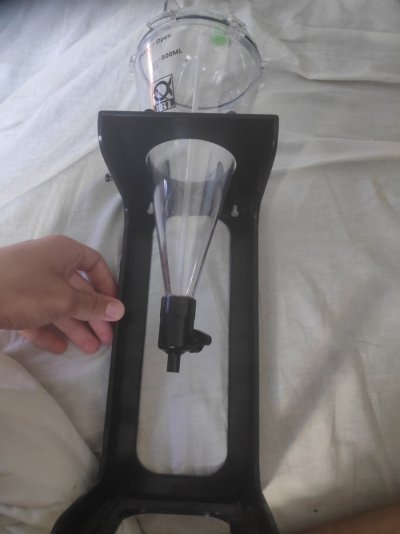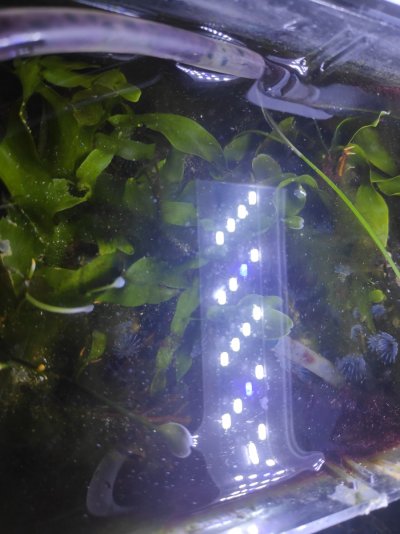In this thread i wish to share my experience of trying to breed peacock blennies (Salaria pavo) and seek advice about raising the fry. Hopefully i can close their lifecycle and this can act as a guide for people thying to breed them in captivity in the future.
My pair of peacock blennies have started laying eggs after i have been keeping them for about a month and a half.They are fed frozen food: mysid shrimp 2 or 3 times a day , sometimes brine shrimp and they rarely get some bits of salmon that i feed to a baby Scorpaena porcus in the same tank. Fyi, i'll definetely have to move him because he is a little as$hole that ate my shrimps and baby mollies. Also, there is a small population of isopods and amphipods the blennies might hunt if they ditn't eradicate them already. It seems that the genus Salaria si quite different from Salarias, as the peacock blennies don't have scraping teeth and eat only meaty foods even tough there's lots of algae and macroalgae around.
The tank size is around 10 gallons and the water temperature is 27° celsius or 80.6° farenheit (i would want it lower but there are heatwaves this summer and it gets like 35° outside so this is the coldest it gets even with lots of evaporation.. There is a wavemaker and two recirculation pumps, one of wich runs a large internal filter with sponge inside.
So far they have laid two clutches in a broken rapa whelk shell and the male is guarding/ ventilating them. The second clutch (29 july 2023) eggs were laid between and around the older eggs that already had eyes developed and i managed to catch that spawning on camera. I'll monitor the new eggs to see exactly how many days they take to hatch. The older eggs seem healthy but haven't hatched yet. The eggs are very very tiny so i plan to feed the minuscule fry an unidentified species of copepod (and their naupli) that i am culturing from algae in my tank. These copepods are very small, abiut half the size of freshwater infusoria/paramecium. I have them in two cut up 2 liter bottles on the windowsil, without aeration. If i run out of them before the fry can eat baby brineshrimp i will try to feed them freshwater paracecium filtered trough a coffe filter. I'm not hoping that i will be able to raise hundreds of larvae, but it would be cool if a few survived eventually.
I caught the adults myself at the end of june in the Black Sea wen they were (probably) spawning inside a cola can stuck between some rocks. It's likely their breeding season right now witch probably helped to condition them to spawn. They are a temperate to subtrobical species that lives mainly in the Mediterrannean See so they may not spawn next year if they have a hormonal problem with the temperature not getting low enough for a "winter period".
Footage of them spawning and egg guarding (from 29 july 2023, and the spawning took place around 11:30/45 to 12:00p.m.)
Salaria pavo spawning in aquarum
Salaria pavo male guarding eggs
Photo of eggs:

Web pictures of eggs:



Alright, i'll update y'all when the fry hatch. I'm awaitimg any questions or advice. (especially advice lol)
My pair of peacock blennies have started laying eggs after i have been keeping them for about a month and a half.They are fed frozen food: mysid shrimp 2 or 3 times a day , sometimes brine shrimp and they rarely get some bits of salmon that i feed to a baby Scorpaena porcus in the same tank. Fyi, i'll definetely have to move him because he is a little as$hole that ate my shrimps and baby mollies. Also, there is a small population of isopods and amphipods the blennies might hunt if they ditn't eradicate them already. It seems that the genus Salaria si quite different from Salarias, as the peacock blennies don't have scraping teeth and eat only meaty foods even tough there's lots of algae and macroalgae around.
The tank size is around 10 gallons and the water temperature is 27° celsius or 80.6° farenheit (i would want it lower but there are heatwaves this summer and it gets like 35° outside so this is the coldest it gets even with lots of evaporation.. There is a wavemaker and two recirculation pumps, one of wich runs a large internal filter with sponge inside.
So far they have laid two clutches in a broken rapa whelk shell and the male is guarding/ ventilating them. The second clutch (29 july 2023) eggs were laid between and around the older eggs that already had eyes developed and i managed to catch that spawning on camera. I'll monitor the new eggs to see exactly how many days they take to hatch. The older eggs seem healthy but haven't hatched yet. The eggs are very very tiny so i plan to feed the minuscule fry an unidentified species of copepod (and their naupli) that i am culturing from algae in my tank. These copepods are very small, abiut half the size of freshwater infusoria/paramecium. I have them in two cut up 2 liter bottles on the windowsil, without aeration. If i run out of them before the fry can eat baby brineshrimp i will try to feed them freshwater paracecium filtered trough a coffe filter. I'm not hoping that i will be able to raise hundreds of larvae, but it would be cool if a few survived eventually.
I caught the adults myself at the end of june in the Black Sea wen they were (probably) spawning inside a cola can stuck between some rocks. It's likely their breeding season right now witch probably helped to condition them to spawn. They are a temperate to subtrobical species that lives mainly in the Mediterrannean See so they may not spawn next year if they have a hormonal problem with the temperature not getting low enough for a "winter period".
Footage of them spawning and egg guarding (from 29 july 2023, and the spawning took place around 11:30/45 to 12:00p.m.)
Salaria pavo spawning in aquarum
Salaria pavo male guarding eggs
Photo of eggs:
Web pictures of eggs:
Alright, i'll update y'all when the fry hatch. I'm awaitimg any questions or advice. (especially advice lol)





















